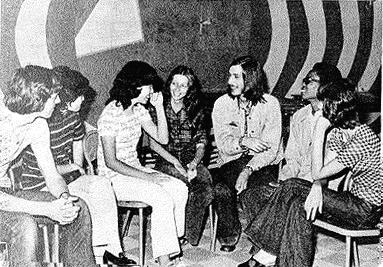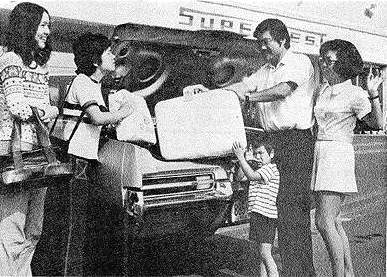| THE NORTH SHORE NEWS - August 9th 1973 Roxboro United Church plays
host
Japanese, Guyanese, Canadians
meet in "rap" session
| |
It was called an "inter- exchange
exchange" when young people from Japan, Guyana and
the North Shore met last Saturday at Roxboro United
Church for a general "rap" session. Over thirty
young people from the three countries met when the
organizers of two exchange programs got together. Frank Quinn of the Roxboro Lions Club and Bob
Vokey of the North Shore Youth Services got together with
the idea of bringing their visitors together for an
informal session. Mr. Quinn was coordinating a visit by
several Japanese students to the North Shore area while
the North Shore Youth Services were hosting the Guyanese
young people.
|
| |
According to Mr. Vokey,
after an initial period of shyness, the young people soon
overcame all communication barriers and began discussing
a wide range of subjects. The
Guyanese students presently visiting Montreal are
returning the visit of several youth from the
North Shore who travelled to Guyana last month. The.
Japanese, numbering about twenty, were part of a long
exchange program, involving several hundred students,
which is based in Toronto.
|

Yasuko
Nehida (third from left) of Osaka, Japan shows
her amusement as Bob Vokey (third from right) of
the North Shore Youth Services makes his point.
Looking on are (1-r) Gary Maavara (N.S.Y.S.),
Milhiyo Kayamihara (Osaka), Elloulse Bonnell
(North Shore), .Howard Hinds (Guyana) and Donna
Robinson (North Shore). The young people met at
.Roxboro United Church last weekend when two
visiting groups from Japan and Guyana got
,together. Trans-Can Photo
|
|
| |
John Salvis of the North Shore Youth
Services sat in on one of the discussions and told how
the gathering went. "When
the thing began, there were groups of people in twos or
threes sitting around the hall. Then people began mixing
and introducing each other. They then found common
grounds to talk on and were soon in two large
groups," explained Mr. Salvis.
The N.S.Y.S. coordinator said the
meeting was a good example of people getting together
without bias or prejudice colouring their attitudes
towards each other.
"The only things these young
people had in common were their youth and their
smiles," Mr. Salvis said.
Mr. Vokey was particularly surprised at
the ability of the young people to communicate despite
limited English on the part of the Japanese students and
the broad West Indian accents of the Guyanese. Some of
the young people went as far as drawing diagrams to
explain their points when the language barrier became.
too much.
|
WOMEN'S STATUS
| |
Some of the subjects discussed by the
visitors and hosts were common interests such as music,
films, and sports. One subject which Mr. Vokey found
particularly enlightening was that on the status of women
in the different countries. Two Japanese girls told the
gathering that Japanese women tend to marry at a
relatively older age - around twenty-four - and that the
women never continue their working careers after
marrying. On the other hand, the
Guyanese pointed out that their women marry at quite a
young age - sometimes as early as fifteen or sixteen -
and have quite a low status in comparison with Canadian
women. Mr. Vokey told of one incident which brought home
this point. He was at home with his visitor and began
washing the dishes. His guest swore it was the first time
he had ever seen a man doing such work.
When told that many Canadian women work
after marriage and often while raising a family, the
Japanese girls reacted with equal surprise.
Mr. Vokey explained that all of the
Japanese young people Were college students while most of
the Guyanese are working to support them- selves - a
factor which naturally left some wide differences in the
experiences of the young people.
Standards of living and relative states
of affluence were not major points of, discussion.
One point which the Japanese found very
striking,, was the ability of the Canadians in general to
make use of their leisure time in very diversified ways -
an ability the Japanese people have not yet developed.
When the topic of discussion came
around to sports, the Japanese seemed involved with their
ancient arts of judo and karate and the American game of
baseball, while the Guyanese young people took more
interest in the British sports such as soccer and
cricket.
|
PERSONAL CONTACT
| |
In summing up the meeting, Mr. Salvis
said, in his opinion, there are two ways of getting
peoples of the world together. It can he done at a high
level in the form of diplomacy where, according to Mr.
Salvis, the people of the country are very often
uninvolved. The second way is through face-to-face
meetings of the people of the various nations. In Mr.
Salvis' view the person-to-person contact is far
superior. "In this day and
age with the jet airplane, it is becoming increasingly
easy for people to travel to other countries and the best
way to get to know the people of the country you are
visiting is to sit down and talk," said Mr. Salvis.
Both Messrs. Salvis and Vokey were
impressed with the smoothness with which the meeting game
off considering the very short notice given to the
parties involved.
|

Japanese visitors to the
North Shore found not only hospitality but in
one case a translator as well. Hosts Mr.
and Mrs. Ronald Tanaka and son Peter, of Plerrefonds
(right) met Tamac Kimura and Keiko Okamoto (left)
when they arrived on the North Shore and Mrs' Tanaka
acted as interpreter for the girls and their 18
fellow students when the language barrier was
too great. Trans-Can Photo
|
|
| |
The Guyanese students will be up north
at Camp Kanawana and will take part in a special
reception at the Sheraton Mt. Royal- hotel where they
will meet the Guyanese Prime Minister who is presently in
Canada for the Commonwealth Prime Ministers' Conference. |
----
|